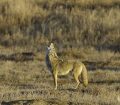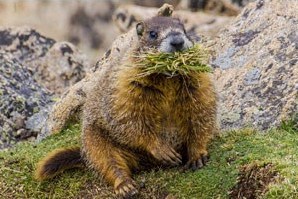The Yellow Bellied Marmot (Marmota flaviventris) is one of the largest members of the squirrel family and makes it’s home in the Rocky, Sierra Nevada and Cascade mountain ranges. They make their homes on Alpine meadows and rocky areas of the mountain side. Fully grown they can weigh as much as 11 pounds and be near the size of a house cat. His closest down hill relative is the Ground Hog.
The Yellow Bellied Marmot gets it’s name, not for being easily frightened, but its golden to rust colored fur on his underside that can stretch up his arms like fuzzy sleeves. They have short tails and stocky appearance due to their thick coats and strong limbs made for digging.
 Living at high altitudes these Marmots typically make their homes in rocky warrens that make it difficult for bears or other predators to dig them out. Safely inside their burrow a family of up to 20 live together headed up by one adult male. When out in the open grazing one Marmot will keep watch over the area and sound the alarm by giving out a loud whistle or bark if danger approaches. When this happens they will make a dash for the nearest rocks and wait for the danger to pass.
Living at high altitudes these Marmots typically make their homes in rocky warrens that make it difficult for bears or other predators to dig them out. Safely inside their burrow a family of up to 20 live together headed up by one adult male. When out in the open grazing one Marmot will keep watch over the area and sound the alarm by giving out a loud whistle or bark if danger approaches. When this happens they will make a dash for the nearest rocks and wait for the danger to pass.
Humans also need to keep a sharp eye out while in Marmot Country. After all they are fat squirrels and always hungry. It’s not unusual to find a hole gnawed through you pack as a hungry Marmot tries to find a tasty lunch inside. You may even find tooth marks on other gear that might smell of food.
Daily life for the Yellow Bellied Marmot is pretty good. It consists of plenty of grazing in the mornings and evening interspersed by laying in the sun. Marmots hibernate each winter so they must bulk up at the end of every summer.
Yellow Bellied Marmots are true hibernators. During the Fall when the temperatures start to drop the Yellow Belly Marmots head underground to sleep through the winter. Deep inside their inside their warrens as far as 20 feet below the ground, they have a room just for sleeping that is lined with dry grass to provide some insulation and no doubt a dry comfy bed.
While hibernating all of the Marmots will pile up and sleep up against one another to provide more body heat and efficient sleeping. Other adaptations for hibernating include the Marmots ability to greatly lower their metabolic rates including lowering their body temperature to 41 degrees Fahrenheit. Their heart rates also decreases to an average of 30 beats per minute and the deep sleeping Marmots only need to take only one to two breaths per minute. This slow down means their reserved fat supplies can go a lot longer even as long as 200 days.
When Spring comes the Yellow Bellied Marmots head back out into the sunshine to once again stretch their legs and begin reproducing. The females usually have a litter of about a half-dozen pups a year. When the male Marmots are about a year old they will venture out and start their own warrens nearby. There they will go back to stuffing themselves, basking in the sun and taking in the mountain views all summer long.





